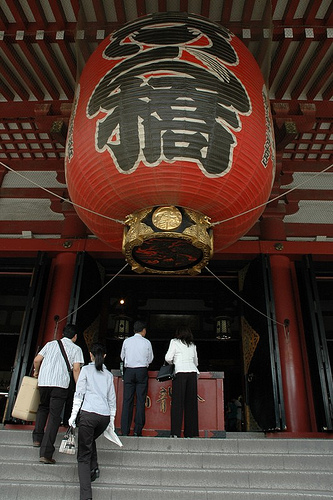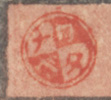About This Print
Source: The Japanese Print Since 1900: Old Dreams and New Visions, Lawrence Smith, British Museum Publications, Ltd., 1983, p. 99The Great Lantern at the Asakusa Kannondo 1934; from a limited edition (first edition) of 100 Woodblock, 360 x 240 mm (image).
The “Kannon Hall” is part of the Sensoji Temple in Asakusa, a fairly Bohemian district of Tokyo before the Second World War. It is famous for its huge paper lantern, of which Hiroshige had done a celebrated print in his One Hundred Views of Edo in the late 1850s. Shiro’s view is similarly constructed to Hiroshige’s, but its rather pessimistic, dark atmosphere is noticeably different from the early master’s cheerful and light-filled version. As often in this artist’s work, the figures have their back to us.
Source: Printed to Perfection: Twentieth-century Japanese Prints from the Robert O. Muller Collection, Amy Reigle Newland, et. al., Hotei Publishing, 2004, p. 112.
The enormously popular Asakusa Kannon Temple (also known as Senso Temple) in Tokyo’s Asakusa district figures prominently in the traditional annual calendar of events and festivals, especially during the temple visits at the New Year which attract large crowds. This print is characteristic of Shiro’s early period. It is representative of the works released by the Watanabe publishing house, as seen in the similar styles of Shiro’s contemporaries, Kawase Hasui (1853-1957); Tsuchiya Koitsu (1870-1949); and others.
Notes on the Original Edition
Source: Modern Japanese Prints, Dorothy Blair, re-print of the 1931 and 1936 exhibition catalogues, The Toledo Museum of Art, 1997.)Print #173. Great Lantern Of The Kwannon Temple, Asakusa (Asakusa Kwannon-do O-chochin)
Huge red paper lantern at the entrance of the temple of Senso-ji Asakusa Park, Tokyo. This temple, generally referred to as Asakusa Kwannon, is one of the most popular Buddhist temples in Japan. 141/4” x 91/2”.
Signed at lower right, Shiro; red seal “Shiro In” (Shiro’s mark). Right margin: the Japanese title; the date, “Showa Ku Nen Saku” (Made in the 9th Year of Show [1934]). Copyright stamp of publisher, Watanabe of Tokyo. Blocks, about 20; superimposed printings, about 25; edition, 100.
Sensoji Asakusa

This is also the site of various historical festivals such as Sanja Festival in May, Hozuki-ichi (Chinese Lantern Plant Fair) in July, and Toshi-no-ichi Fair in December. Sanja Festival held on the 17th and 18th of May is one of Tokyo's three largest festivals, and its historical origins trace back to the Kamakura period (1192-1338). July 10th, the Kannon Festival day (festival day for the Goddess of Mercy) is also the day of the Hozuki-ichi Fair, where many stalls are set up on the Senso-ji temple grounds to sell Chinese lantern plants. The Toshi-no-ichi Fair is held in late December and a variety of New Year's sundries and good-luck charms are on sale.
Asakusa has been an amusement district since the Edo Period, but particularly from the middle of the Meiji Era until just before the war, it flourished as Japan's most bustling entertainment area. It boasted some of Japan's most modern buildings including a landmark building popularly known as Asakusa 12-kai, a 52-meter (171-foot) brick observation tower that was Japan's tallest structure at that time, as well as an opera house. Japan's very first cinema was located here, and it was the site of popular culture offering opera, theatrical revues, light comedy, and vaudeville. Countless entertainers and actors made their start in Asakusa.
Senso-ji temple as well as the entire Asakusa district was burned to the ground following the Great Kanto Earthquake in 1923 and again during the Second World War. After the war, both Senso-ji temple and Kaminarimon were restored. Although Asakusa did regain some of its former glory as a center for entertainment for a short period of time, young people gradually shifted their attention to new entertainment districts constructed near the major railway stations such as Shinjyuku or Shibuya. Currently, although Asakusa today does not retain much of its trend-setting past, it still attracts a throng of visitors who immerse themselves in that old downtown feeling.
Print Details
| IHL Catalog | #36 |
| Title | The Great Lantern of the Senso Temple, Asakusa 浅草觀音堂大提灯 Asakusa Kannon-dō Ō-chōchin |
| Series | |
| Artist | Kasamatsu Shirō (1898–1991) |
| Signature |  |
| Seal | Shirō saku (work by Shirō) 紫浪作 |
| Date | originally published 1934, Spring |
| Edition | Later edition (c. 1946-1957) with red 6 mm Watanabe seal in lower left hand corner of image. (see below) |
| Publisher |  seal reading ワタナベ Watanabe [Marks: seal 08-034; pub. ref. 576] |
| Impression | excellent |
| Colors | excellent |
| Condition | excellent- two mounting spots on top verso where previously attached to original folio |
| Miscellaneous | Asakusa Kwannon-do O-chochin (r. margin). The Great Lantern of the Kwannon Temple, Asakusa |
| Genre | shin hanga (new prints) |
| Format | ōban tate-e |
| H x W Paper | 15 1/4 x 10 1/4 in. (38.7 x 26 cm) |
| H x W Image | 14 1/4 x 9 1/2 in. (36.2 x 23.8 cm) |
| Collections This Print | Los Angeles County Museum of Art M.73.37.349 (C-type Watanabe publisher seal); Smithsonian Freer Gallery and Arthur M. Sackler Gallery S2003.8.472 (E-type Watanabe publisher seal); TheBritish Museum 1981,0225,0.4.b (6mm Watanabe round seal lower right);Museum of Fine Arts, Boston 51.1752 (Watanabe 6mm circular seal, printed in red ink, lower left corner as in my edition);National Museum of Modern Art, Tokyo P00211-041 (unknown edition); MAK Vienna: Austrian Museum of Applied Arts/Contemporary Art K.I. 13606-004 (unsealed); Jordan Schnitzer Museum of Art MWJ51:K2 (E-type Watanabe publisher seal); Portland Art Museum 91.5.2 (E-type Watanabe publisher seal) |
| Reference Literature | Catalogue Raisonné: W-14 as listed in Shiro Kasamatsu - The Complete Woodblock Prints, Dr. Andreas Gund, self-published by the author, 2001, Tokyo; Printedto Perfection: Twentieth-century Japanese Prints fromthe Robert O. Muller Collection, Amy Reigle Newland, et. al., HoteiPublishing, 2004, p. 112, plate 102; TheJapanese Print Since 1900: Old dreams and new visions, LawrenceSmith, British Museum Publications, Ltd., 1983, p. 86, plate 80, p. 102; The Changing City as Depicted in Modern Woodblock Prints - Tokyo in Transition, Edo-Tokyo Museum, 1996, p. 170; Hanga ni miru Tokyo no fukei; Kanto daishinsai kara senzen made, Ota Kuritsu Kyodo Hakubutsukan, 2002, pl. 235, p. 59. |
8/19/2021
8/6/2018


